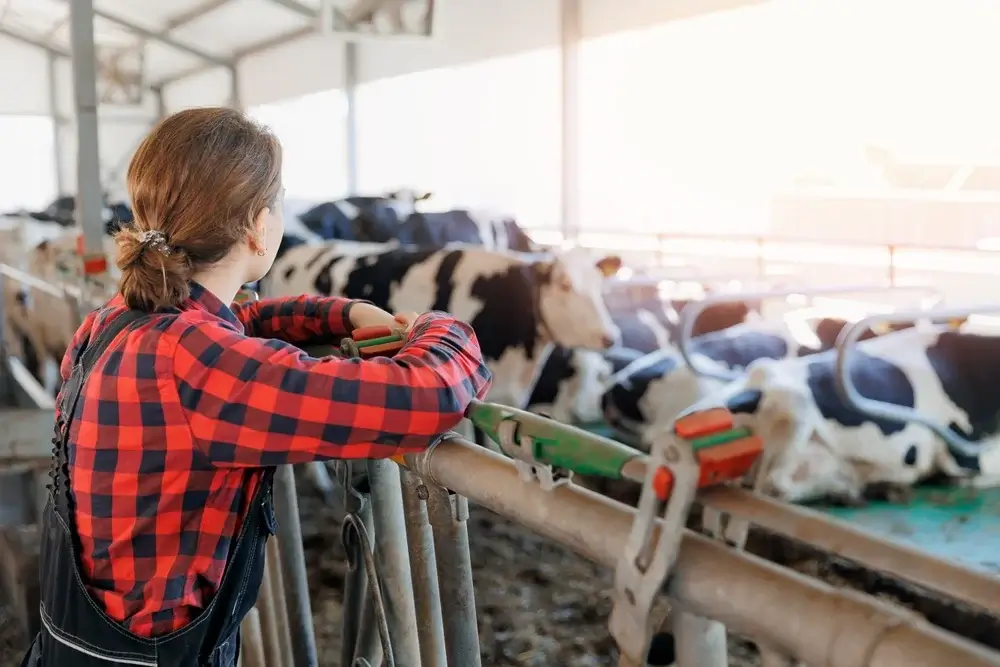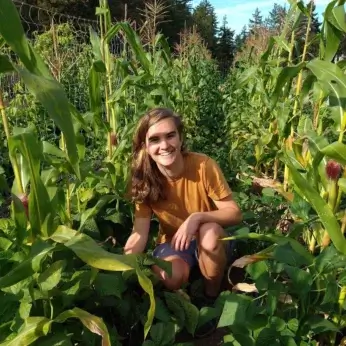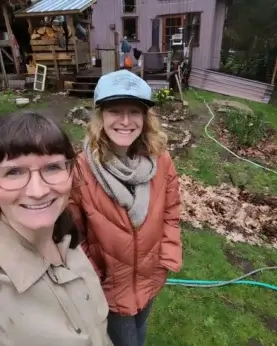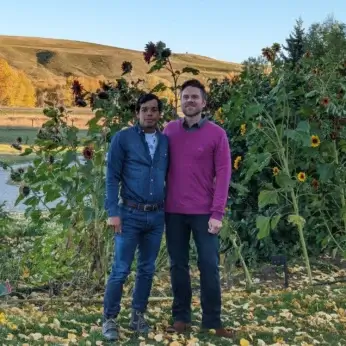Modern Farmer sat down with the co-founder of Young Agrarians, a farmer-to-farmer resource for young people, to find out what might hamper young folks looking to enter the agriculture industry.

This story is part of our Future Farmers series, highlighting the joys and hurdles of a career in agriculture today. You can read more of this series here.
For young people interested in a career in agriculture, there can be many roadblocks in their path. The price of land continues to rise, grants and educational opportunities can be hard to come by and there’s a steep learning curve for folks who didn’t grow up in a farming family.
As we kick off our coverage of Future Farmers, we wanted to hear directly from the people facing these impediments: the young farmers themselves. What issues are they really grappling with? Is our perception of the agricultural landscape accurate or do they see a different future playing out?

Sara Dent. Photography courtesy of @youngagrarians/Instagram.
Modern Farmer sat down with Sara Dent, co-founder of the Young Agrarians, to talk about issues young farmers face and some surprising ways we can start to solve them.
This interview has been edited for length and clarity.
Modern Farmer: It seems that there are a lot of issues that young farmers face when starting out: cost, a knowledge gap, land access and more. Do you see a common thread that ties these issues together or does it seem like we’ll have to tackle things individually?
Sara Dent: Well, just to start, I’d like to note that I’m on Tla’amin, Klahoose and Homalco Nation land. And I think this conversation is really fascinating, because if you look before colonization, and see how the land was stewarded and the abundance of systems, you look at how colonization came in that it used up a lot of the natural resources. It broke up the people and the ecology of the landscape and parceled it into the British land title system. And now we’re in 2024, we have market failure conditions for agriculture. And there’s a low tolerance at the institutional level for recognizing those market failure conditions.
When I first started Young Agrarians, it was really driven by enabling coordination in the sector and addressing three main barriers, which is access to land, access to capital and access to knowledge.
The piece that we could start with was access to knowledge and facilitating that through farmer-to-farmer conversations. Farmers are the ones that train new farmers and support new people to get their feet underneath them. We started working on the land access piece in 2016, and now we’re trying to increase influence around the access to capital piece, advancing policy at a municipal, federal and provincial level. But policy is really like a living body. It’s composed of everybody. It’s composed of the eaters, it’s composed of the people growing the food, it’s composed of the banks [that] are lending it to the agricultural space, governments that are regulating agricultural space and creating the eligibility criteria that evaluates the whole sector.
And we are seeing a major decline in agriculture; the farming population in Canada is very low. Indeed, the last census showed that [of the 262,455 farm operators] fewer than 23,000 were under the age of 35.
MF: So, if policy is the most, let’s say, unwieldy of the areas of influence you mentioned, what are the policy challenges?
SD: One of the big policy challenges for new farmers in the country is that, for a lot of governments, their norm is bigger industry, the policy is really driven by bigger industry, bigger farms. But when you look at new-generation people coming in, they have to start somewhere. So, we often talk about “scale-appropriate” policy.
For young people entering the sector, people that are actually accessing land, how do we support them? And then the people who are in that startup window of your one, two, year five? And they’re all starting at different scales. But we really try to focus with government on talking about scale appropriate. The old market analysis says “the bigger the better.” But a lot of big farms have huge debt margins, and if they have a bad year, it can be really damaging for them. However, what they have going for them is if they own the land, at least they have that equity in the land.
You can see that smaller-scale models might actually be more effective financially than larger-scale models. New farms today have to figure out what their value proposition is, they have to be really super focused to figure out how they’re going to survive and what their niches are. So, in my mind, one of these big policy shifts is understanding that bigger isn’t always better.

Ardeo, the farmer at Rake & Radish Farm in Saanich, BC. Ardeo was matched to farmland through the B.C. Land Matching Program in 2020. Photography via @youngagrarians/Instagram
MF: You mentioned that there are three main areas that new farmers can struggle with: access to capital, knowledge and land. Let’s start with capital. Why is it more difficult for young people to get access to capital or loans?
SD: So, traditional lending is based on leveraging asset as collateral in order to get approved for a loan. If you look at new-gen farmers that are coming in, that don’t necessarily own the land, so they have nothing to offer up as collateral, and they aren’t able to access traditional lending. They can’t afford to buy the property, they can’t qualify for that mortgage and they can’t access the lending.
What we’re working towards is getting the Canadian Agricultural Loans Act updated so that it allows character-based lending and working capital for farmers, so that they don’t have to own the land in order to access the lending program. There’s a really interesting loan program out of Quebec called FIRA, the originator of which, Paul, has done incredible work. It’s a land acquisition fund, and then they sell it back to the farmer as they get their business underneath them.

Kailli from Dancing Dandelion Farms (left) mentors Lolo from Buttercup Sandwich Florals. Photography via @youngagrarians/Instagram
But there’s a big lending gap in the country today. For example, there’s no provincial lender in British Columbia that does character-based lending. In Ontario, the Fair Finance Fund has a national fund for BIPOC candidates, because those candidates weren’t able to get their loans from the traditional lenders. For example, First Nations farmers on reserve land, they aren’t the title holder of the land, so accessing that loan capital is just not possible.
MF: Access to land feels tied into the access to capital issue, as well. Many people just can’t afford to purchase land.
SD: Yeah, absolutely. Every year, farmland values are published across the country, looking at the per-acre rates, and I always find the per-acre rates a little disingenuous, because you might have a per acre average rate for an entire province, but if you’re trying to buy something in northern BC versus southern BC, it’s going to be completely different per acre.
But for people who can’t acquire the land, leasing becomes an important option for new farmers who are just getting their feet underneath them—and, you know, making sure that farming is really for them, that they have a value proposition in the business that they’re operating, that they’re working at the right scale. So, we’re running our BC Land Matching Program, putting out resource guides for farmers across the country to help them navigate that leasing space. Because when you’re leasing, you’re at risk of losing the property if the owner sells. Or what if the owner dies, what if the kids inherit the land? How do you negotiate a lease that has all the right terms in it for your agricultural operation? That’s part of the educational resource work that Young Agrarians has been doing over the last decade, to try and prepare new entrants better for leasing properties. We learned a lot from looking at the US models, like Land for Good and California FarmLink.
MF: And then lastly, there’s access to knowledge. Young Agrarians has an apprenticeship program to pair up new farmers with working mentors to help bridge that gap.
SD: Yeah, we work with farmers who are doing agri-ecology, who want to do education and train. I think we’ve had something like 70 farms work in the program and a little over 80 young people go through the apprenticeship program, but in the big picture, we actually need about 500 of apprenticeships and farms per province. Right now, we’re running that program in Western Canada, British Columbia to Manitoba. And the question is, will that program work at a national offering? The complexity there is finding the right farms and then also having things like housing and being well suited to being educational.
It’s really beautiful when somebody comes in and they have this life-changing experience and the light is turned on and they’re in love with farming and that’s their pathway forward.
MF: It must be so gratifying when it feels like a match between apprentice and farm really clicks.
SD: That’s why I still do this work. We get notes from people regularly, like someone who took a business boot camp course, and then you talk to them two years later, and they’re operating their business. And there’s a lot of beautiful stories that have come out of the network that definitely keeps the staff going.

Steve and Julian of Milpa Naturals are growing their farm and business with the help of the Business Mentorship Network. Photography via @youngagrarians/Instagram
MF: We’ve talked about some community-level and grassroots solutions, like your apprenticeship program. But what might solve some of these issues at a federal or policy level?
SD: I started doing some national policy writing stuff on behalf of the organization in 2021. And I started to understand that there were a lot of people at the institutional level who were interested in these issues, but the knowledge gap (from the policy makers) was significant.
One thing I talk a lot about is eligibility criteria for new entrants. I think that’s really important, because new farmers are totally under invested in Canada and arguably also in the United States, in North America in general, perhaps even globally. They’re extremely under invested, so getting people to think about their eligibility criteria is really key.
I could be in a meeting with somebody working on eligibility criteria for a financial loan program and I’ll say ‘could you put a $50,000 greenhouse on your credit card and then wait to get reimbursed months later?’ And many people realize, ‘oh, yeah, that’s right. I can’t do that. I can’t just go out and buy all this equipment on my credit card and wait to get repaid for it.’
So, I’ve been addressing the elephant in the room by going directly for the eligibility criteria. Because without it, the farmers that look at this application form are just never going to be able to access your programs.
MF: That sounds like a great entry point into this conversation.
SD: Exactly. And some of the legislation needs to change, and a lot of it is just getting the right people at the table over and over to change the cultural conversation.
This story is part of our Future Farmers series, highlighting the joys and hurdles of a career in agriculture today. You can read more of this series here.


